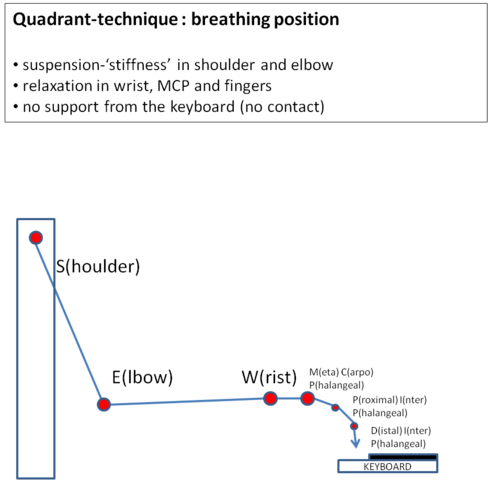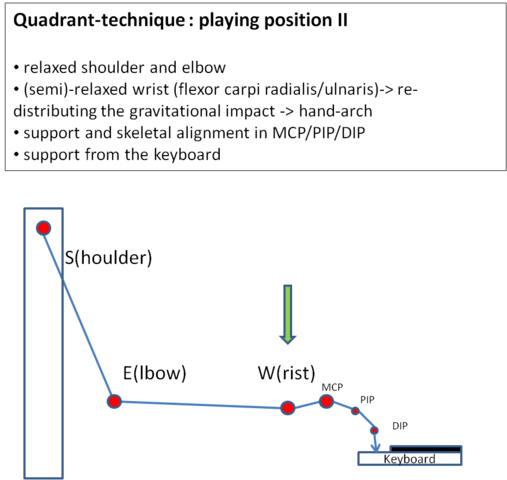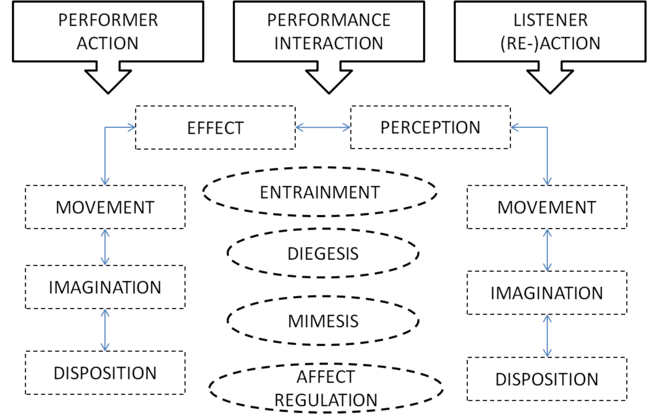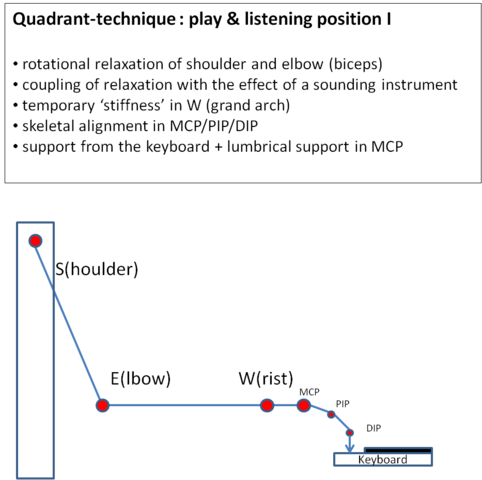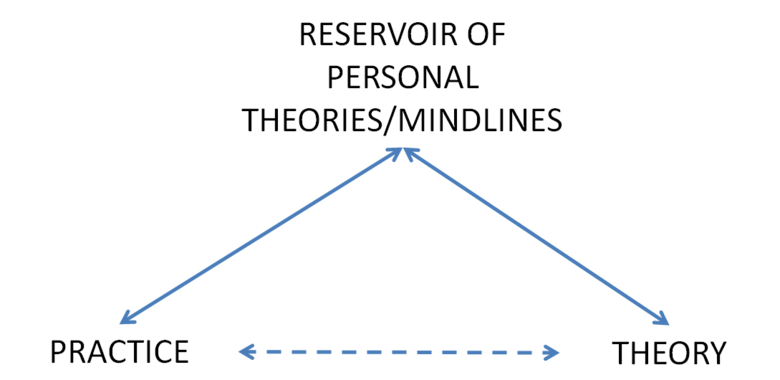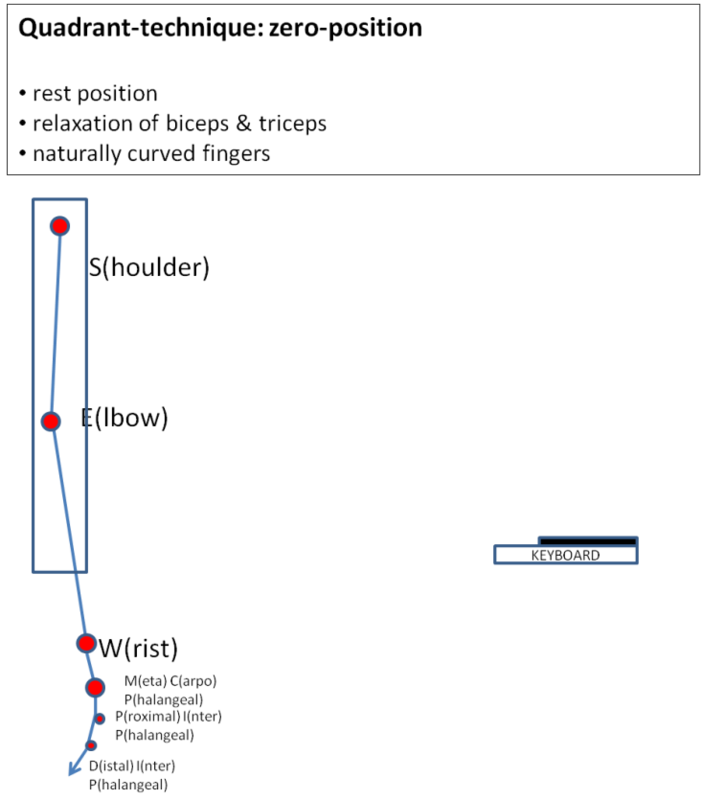The output-impact sequence that titles this seminar bears family resemblances to the time-honoured and stormy relation between theory and practice. Although prima facie the output of practice-based research seems to hold the potential to bypass this dialectical tension by its proclaimed grounding in practice, experience in the field learns that the flow of research outcomes does not always carve out its own natural channels of dissemination. Therefore, the situation may benefit from some preliminary epistemic engineering in order to better understand the bottlenecks and from that to create the cognitive breakthroughs needed in a field dominated by tradition and an aura of splendid isolation. This paper aims at introducing the contours of a meta-practical framework that allows not only for the mapping, travelling, exchange and development of knowledge within the known territories of musical practice but also beyond, into the sphere of the sciences and humanities, leading to a prototype of a bio-culturally informed musician.
The proposed framework will be presented by introducing three of its important building blocks, being:
- A social realist account regarding the generic structure of discourses and knowledge fields in terms of verticality and horizontality. This structural approach has the benefit of being able to generate an encompassing epistemic map characterizing different types of knowledge in terms of their relation to a practical context and their capacity to develop over time.
- The introduction of ‘personal theory’ as a mediator between theory and practice, thus creating a triangular model that adds dynamism and movement to the rather static and segmented nature of the epistemic map outlined earlier.
- The development of topical attractors that have anchor points in both practical and academic fields and operationalize the development of an integrated and extendable knowledge base for musicians.
A brief case-study regarding arm movement in piano playing will be presented in order to illustrate in a more tangible way the generative impact of the proposed meta-practical structure on the development of educational strategies. Information stemming from such diverse fields as neuroscience, movement studies, social psychology, philosophy, musical practice and personal theory will be linked and give rise to an informed view on a fundamental but still underdetermined element of piano technique.
Arx, V. A. von. (2014). Piano lessons with Claudio Arrau: a guide to his philosophy and techniques. New York: Oxford University Press.
Bernstein, B. (1981). Codes, modalities, and the process of cultural reproduction: A model. Language in Society, 10(03), 327. doi:10.1017/S0047404500008836
Bernstein, B. (1999). Vertical and Horizontal Discourse: An essay. British Journal of Sociology of Education, 20(2), 157–173. doi:10.1080/01425699995380
Bernstein, B. B. (1996). Pedagogy, symbolic control, and identity: theory, research, critique. London ; Washington, D.C: Taylor & Francis.
Breithaupt, R. M. (1906). Die Naturliche Klaviertechnik, Teil I: Handbuch der Modernen Technik und Spielpraxis; Teil II: Die Grundlagen des Gewichtspiels; Teil III: Praktische Studien. Spielpraxis (5th ed.). Leipzig: C.F. Kahnt.
Carr, W. (1980). The Gap between Theory and Practice. Journal of Further and Higher Education, 4(1), 60–69. doi:10.1080/0309877800040107
Cross, I. (2001). Music, Cognition, Culture, and Evolution. Annals of the New York Academy of Sciences, 930(1), 28–42. doi:10.1111/j.1749-6632.2001.tb05723.x
Csikszentmihalyi, M. (1991). Flow: the psychology of optimal experience. New York: HarperPerennial.
Elsner, B., Hommel, B., Mentschel, C., Drzezga, A., Prinz, W., Conrad, B., & Siebner, H. (2002). Linking Actions and Their Perceivable Consequences in the Human Brain. NeuroImage, 17(1), 364–372. doi:10.1006/nimg.2002.1162
Feldenkrais, M. (1990). Awareness through movement: health exercises for personal growth (1st HarperCollins pbk. ed.). San Francisco: HarperSanFrancisco.
Fraser, A. (2003). The craft of piano playing: a new approach to piano technique. Lanham, Md: Scarecrow Press.
Friedman, R. S., & Förster, J. (2000). The effects of approach and avoidance motor actions on the elements of creative insight. Journal of Personality and Social Psychology, 79(4), 477–492. doi:10.1037//0022-3514.79.4.477
Furuya, S., Osu, R., & Kinoshita, H. (2009). Effective utilization of gravity during arm downswing in keystrokes by expert pianists. Neuroscience, 164(2), 822–831. doi:10.1016/j.neuroscience.2009.08.024
Gabbay, J., & le May, A. (2004). Evidence based guidelines or collectively constructed “mindlines?” Ethnographic study of knowledge management in primary care. BMJ, 329(7473), 1013–0. doi:10.1136/bmj.329.7473.1013
Gallagher, S. (2005). How the body shapes the mind. Oxford; New York: Clarendon Press.
Goebl, W., & Palmer, C. (2013). Temporal Control and Hand Movement Efficiency in Skilled Music Performance. PLoS ONE, 8(1), e50901. doi:10.1371/journal.pone.0050901
Holstege, G., Bandler, R., & Saper, C. B. (Eds.). (1996). The emotional motor system. Amsterdam ; New York: Elsevier.
Jarvis, P. (1999). The practitioner-researcher : developing theory from practice. San Francisco: Jossey-Bass.
Jencks, C. (2000). EP, Phone Home. In H. Rose & Rose (Eds.), Alas Poor Darwin. Arguments against Evolutionary Psychology. London: Vintage.
Ko, Y.-G., Challis, J. H., & Newell, K. M. (2003). Learning to coordinate redundant degrees of freedom in a dynamic balance task. Human Movement Science, 22(1), 47–66. doi:10.1016/S0167-9457(02)00177-X
Langford, E. (2008). Mind & Muscle An Owner’s Handbook. Garant Uitgevers N V.
Latash, M. L. (2010). Stages in learning motor synergies: A view based on the equilibrium-point hypothesis. Human Movement Science, 29(5), 642–654. doi:10.1016/j.humov.2009.11.002
Lehmann, A. C. (2007). Psychology for musicians: understanding and acquiring the skills. Oxford ; New York: Oxford University Press.
Lobkowicz, N. (1967). Theory and Practice: History of a Concept from Aristotle to Marx. University Press of America, Incorporated.
Mark, T. C., Gary, R., Miles, T., & Conable, B. (2003). What every pianist needs to know about the body: a manual for players of keyboard instruments : piano, organ, digital keyboard, harpsichord, clavichord. Chicago: GIA Publications.
Pacherie, E. (Ed.). (2002). Emotion and action. Stanford, Calif.: CLSI.
Parncutt, R., & McPherson, G. (Eds.). (2002). The science & psychology of music performance: creative strategies for teaching and learning. Oxford ; New York: Oxford University Press.
Polanyi, M. (1958). Personal knowledge: towards a post-critical philosophy. London: Routledge.
Refsum, G. (2007). Personal theory towards a model of knowledge development for design practitioners. NORDES, 2. Retrieved from http://www.nordes.org/opj/index.php/n13/article/view/165.
Schön, D. A. (1983). The reflective practitioner : how professionals think in action. Aldershot: Ashgate.
Taruskin, R. (1995). Text and act: essays on music and performance. New York: Oxford University Press.
Usher, R., & Bryant, I. (1989). Adult Education as Theory, Practice, and Research: The Captive Triangle. Taylor & Francis.
Vanmaele, J. (in preparation). Action & Interaction in Music: towards a bio-culturally inspired performance practice of Western Art Music. Leiden University.
Weizsäcker, C. F. von. (1973). Information und Imagination : Vortraege von Carl Friedrich von Weizsaecker [et al.]. München: R. Piper.
This contribution zooms in on the potential impact of extra-disciplinary research output on musical practice in general and the performance of composed music in particular. Although technological advances in our information age and renewed institutional architectures in the higher education area in recent decades have been rather generous in facilitating access to an abundant amount of information, musical practice and pedagogy still seem to be reluctant (or unable) to meet the challenge of practically engaging with knowledge and insights generated by an extensive field of academic and para-academic enquiry.
The grounds for such a state of affairs seem to be both of an ideological-epistemic nature as well as of a more practical and operational kind. In what follows these systemic bottlenecks will be succinctly discussed on the basis of a focal case-study; a way forward will be proposed leading to the framework of a bio-culturally inspired performance practice of Western Art Music.
CASE-STUDY: THE BASIC STROKE IN PIANO PLAYING
Extra-disciplinary informational units
The basic stroke in piano playing is a crucial factor in the development of a pianist’s instrument-directed movement repertoire and different schools of piano playing formulate (implicitly or explicitly) a variety of answers related to the simple question: how to generate the sound of a single and sustained note on a piano in an effective and durable way? The focus of attention among pianists addressing the issue will be on the position and involvement of the knuckles, wrist and shoulder and on the use of muscle-power and gravitational forces. Most likely, the confrontation of ideas will give rise to a pre-Socratic debate ruled by idiosyncratic opinions, cherished beliefs, personal judgements, powerful traditions and heated but often unresolved dispute[i]. One could wonder then if the invocation of extra-disciplinary insights holds the potential of being informative and inspirational to such discussions and if it can meet the expectations of contributing to the realisation of a shared ground to which various considerations could refer to and on which an advancement of insight could be based. What follows is a selection of five scientific units of information drawn from a variety of academic disciplines and chosen with an eye to locating informational units that could be of interest to the issue at hand.
In a 2009 article in Neuroscience Fuyura et al. document the results of an experimental set-up designed to measure “a skill-level-dependent interaction between gravity and muscular force when striking piano keys” and concluded that that “a balance shift from muscular force dependency to gravity dependency for the generation of a target joint torque occurs with long-term piano training”. (Furuya, Osu, & Kinoshita, 2009)
2. Volume 107 of the series Progress in Brain Research is dedicated to a discussion of the emotional motor system that seems to be operative in patients with lesions of voluntary motor control systems and maintain normal facial motor control during emotional display. (Holstege, Bandler, & Saper, 1996)
3. In a 2002 article in Neuroimage Elsner et al. revisit William James’sideomotor principle and conclude that “ideomotor learning consists in acquiring a consistent relationship between a motor event and a sensory event” (Elsner et al., 2002)
4. In a 2000 article in the Journal of Personality and Social Psychology Friedman et al. report on “The Effects of Approach and Avoidance Motor Actions on the Elements of Creative Insight” and found that arm flexion facilitates insight-related processes and that arm extension facilitates analytical reasoning (Friedman & Förster, 2000)
5. In a recent article Goebl et al. investigate the temporal control and hand movement efficiency in skilled music performance and conclude that: “more research is necessary to conclusively determine the use of intrinsic and extrinsic muscles in piano performance.” (Goebl & Palmer, 2013)
Information-types
An extensive discussion on the specific contributions and implications of these informational units would evidently exceed the scope of this paper; we will limit ourselves to more general observations in terms of the information-types that can be extracted from the examples mentioned above thereby assessing their informational potential.
Confirmation:
Informational unit 1 seems to be of a confirmatory type in that it adds to the credibility of an element of piano-technique that has already been established in a number of practical contexts (e.g. Breithaupt, 1906). Its contribution to practice however is not limited to adding credibility to certain insights but also opens up perspectives and informational avenues to a very lively and enriching debate on degrees of freedom and redundancy in the motor system (Ko, Challis, & Newell, 2003) and stages in skill acquisition (Latash, 2010).
· Explicitation:
Informational units 2 and 3 explicate in a very clear and principled way implicit and vague everyday intuitions and experiences and bring them within the structural purview of a limited number of principles through integration and subsumption.
Inspiration:
Informational unit 4 adds a new element to the spectrum that has not (yet) found its way into piano-pedagogy and is also absent in music-oriented disciplinary handbooks (Lehmann, 2007; Parncutt & McPherson, 2002).
· Agenda-setting:
Informational unit 5 expresses a shared unresolved concern that would benefit from future collaborative research.
From recontextualizaton to reproduction
The Informational units that we have presented live an isolated and fragmented life in academia and only seem to become of value when they are being recontextualised (B. Bernstein, 1996, p. 54) within a practical agenda and in dialogue with personal theories and practice-proof accounts of instrumental technique. Within the framework of an output-impact trajectory they find their ultimate destination in the field of pedagogical reproduction (B. Bernstein, 1981).
The ‘quadrant-technique’[ii] is a four-stage reproduction model that is used in coaching pianists at various levels of proficiency and incorporates amongst other elements also the informational units that we have mentioned above. The pedagogical tool is schematically represented by figures 1-4 and closes the circle from extra-disciplinary output to intra-disciplinary impact.
THE LARGER PERSPECTIVE: TOWARDS A BIO-CULTURALLY INFORMED PERFORMANCE PRACTICE
We have by means of an example made a first assessment regarding the potential of extra-disciplinary information. Generalizing this case-study into the direction of a more generalized and systematic framework for integrating extra-disciplinary knowledge of course is another cup of tea and poses enormous operational and epistemic defiances. Querying the information galaxy can result in a bombardment of input of which only a selection was presented in our case-study. Moreover, within the selection, reference was made to punctual research outputs that obey to the scientific method (natural sciences) but the range could easily be extended to insights that hold a humanities or a para-academic background and relate to topics such as embodiment (Gallagher, 2005), expression (Pacherie, 2002), flow (Csikszentmihalyi, 1991), body-control (Feldenkrais, 1990; Langford, 2008), etc.
This abundance presents itself as a huge interpretative, integrative and selective challenge. Every unit of information is encircled by a certain context of discovery, critique, justification, interpretation and application; add to that cocktail the proliferation of specialized languages, sub-disciplines and research-niches and one can easily lose track in overambitious expectations, naïve conclusions and an incohesive and randomly selected knowledge-base. Informing practice requires coordinated and systematic action.
Hereafter a bio-cultural informed framework for musical performers is presented as a prototype-model designed to meet some of these challenges. The basic tenets are summarized in three steps.
Step 1: Personal theory in a triangular model
Connecting the realm of musical practice to a broader field of epistemic enquiry inevitably leads to a long-standing issue of debate, that of the relation between theory and practice or between thought and action (Lobkowicz, 1967). In scholarship related toprofessional knowledge and adult learning (Carr, 1980; Jarvis, 1999; Polanyi, 1958; Schön, 1983; Usher & Bryant, 1989) a way out of this epistemic dualism is being offered by the inclusion of ‘personal theory’ as a link in a continuum between theory and practice. Personal theory refers to a systematic and transmissible understanding gained from reflection on practical experience. It consists of beliefs, opinions, understandings and rules of thumb that have been pragmatically abstracted from particular practical contexts or that have been retained from existing practice traditions.
Personal theory is the epistemic backbone by which practitioners judge
new practice situations and is amenable to revision if new situations necessitate it. Moreover, if the reservoir of personal repertoires (Bernstein, 1999) within professional practice doesn’t seem to be able to provide efficacious answers the practitioner will turn to extra-disciplinary modes of information, including academic theory (Refsum, 2009, p. 6). Figure 5 is an attempt to summarize the basic idea. The dotted line indicates the arduous informational exchange between theory a practice ; ‘mindlines’ is a notion that has appeared in literature on the evidence-based status medical practice and is complementary to the notion of personal theory (Gabbay & le May, A., 2004).
Step 2: music as bio-cultural phenomenon
Our case-study clearly indicated that an informed performance practice shouldn’t per se limit itself to being historically informed. The bio-cultural perspective envisages the expansion of a musician’s interest from history into the broader realm of socio-culturalIy enquiry and eventually into the situated biology of musicians. Such an integrative approach makes sense only if we consider musics as cultural particularisations of the human capacity to do so (Cross, 2001, p. 38), which leaves us with the ultimate question what these capacities consist of.
Step 3: Topical attractor model
The third step is an operational one and is directed at creating a common ground between practice and theory by identifying basic human musical capacities that have referents both in the personal theories of musicians and as well as in academia and hold the potential to function as integrated attractors in a field of abundant information. The method that has prompted a first prototype of such a shared model has been twofold. A bottom-up and discovery-led approach led to a structured database consisting of almost 6000 informational units; a top-down enquiry countered the former by analysing, comparing and looking for convergences between several models of performance employed in psychology, sociology, philosophy, neurology and artistic practice.
This dual method ultimately was synthesized in a topical attractor model where action, interaction and (re-)action operate as the main-attractors in a chaotic field of information. They represent the basic human capacities that enable musical experience and are situated at the top of an inverted tree-model that harbours various levels of sub-attractors and prolongations. A first line of sub-attractors related to ‘action’ consists of ‘disposition’, ‘imagination’, ’movement’ and ‘effect’ and the attractor ‘interaction’ is in a first instance further developed in terms of ‘entrainment’, ‘diegesis’, ‘mimesis’ and ‘affect regulation’.
CONCLUSION:
We covered a lot of territory in only a few steps in order to reach the fertile grounds of a bio-culturally informed performance practice. The details of this endeavour and the rationale behind certain choices will be documented in a doctoral dissertation dedicated to this topic (Vanmaele, in preparation). One last thing however seems to be of crucial importance and at the core of the project. The notion of ‘information’ is commonly considered to produce ‘yes’ or ‘no’ answers’ to practical questions (Weizsäcker, 1973) but that is not what a bio-culturally informed practice is aiming at. Between the limits of biology and the possibilities of culture, there is a precious field of human freedom (Jencks, 2000) which ultimatily necessitates the fine-tuning of the term ‘informed practice’ into an inspired one.
“only when we know something about the sources of our contemporary practices and beliefs, when we know something about the reasons why we do as we do and think as we think, and when we are aware of alternatives, can we in any sense claim to be free in our choice of action and creed, and responsible for it.” (Taruskin, 1995, p. 19)
Joost Vanmaele (°1971) is a pianist, teacher, researcher and a former artistic staff member and research coordinator at the Orpheus Institute, Gent. He trained as a pianist at the Royal Flemish Conservatory of Antwerp (Levente Kende) and at the Staatliche Hochschule für Musik in Freiburg (Michel Béroff).
The personal confrontation with a partial and chronic motor deficit in 1996 led to an extensive and interdisciplinary exploration into to the various ways in which the act of playing a musical instrument comes into being. A doctoral dissertation titled “Action & Interaction in Music: towards a bio-culturally inspired performance practice of Western Art Music” will be presented shortly at the Leiden Academy of Creative and Performing Arts and proposes a framework that connects practical concerns to a broad-spectrum and bio-cultural knowledge base.Joost Vanmaele currently teaches piano at the Municipal Conservatory of Bruges.
